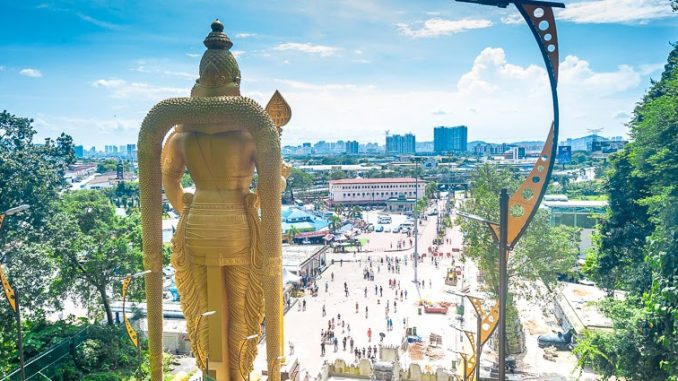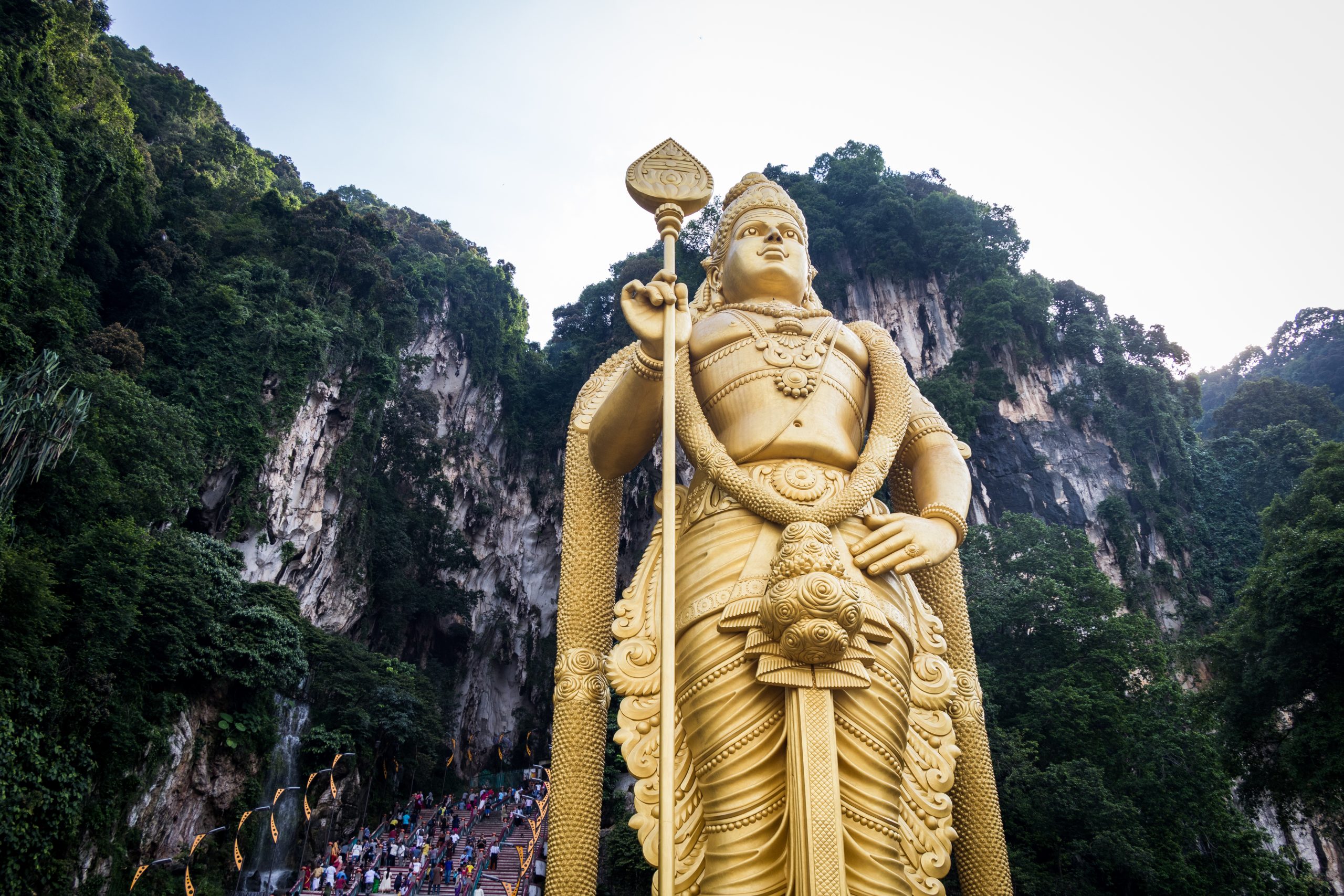
Murugan Statue of Batu CavesBatu Caves is a unique confluence of natural wonders and embellished by human interventions. At the mouth of these ancient natural caves that have been in existence thousands of years ago, there is a tall golden statue of Murugan. It seems as if a man is competing with God in creating.
On the border of Kuala Lumpur, Malaysia, these natural caves exist on a limestone hill which is called Batu Caves. While going towards these caves, you do not even realize that you have come out of the city. The only sign of the existence of these natural caves is the presence of a hill covered with rocks. But, as soon as we reach these caves, our sight is captivated by the huge statue of Murugan painted in golden color. As soon as it becomes visible, you know that you have reached your destination. The statue of Murugan standing facing the city has its back towards the caves. Seeing this scene, it seems as if Murugan is the guardian of the caves and is also inspecting the city.
READ ALSO: Kapilvastu – Capital of Buddha’s Shakya Dynasty in Nepal
Tour of Batu Caves – Sightseeing of Kuala Lumpur
Murugan Statue of Batu Caves
An Indian-origin Tamil businessman had installed the statue of Murugan here because to him this cave looked like Murugan’s spear. Since the 19th century, the place has become the venue for the annual Thaipusam festival. It is a Tamil festival celebrated around January or February. During this festival, a grand procession takes place from the Mahamariamma temple located within the city to the Murugan temple. Even today this tradition is continuing.
The height of this huge statue of Murugan is 140 feet. It is the tallest statue of a Hindu god in Malaysia and the third tallest statue in the world. The Murugan Statue of Batu Caves took three years to build for which 15 craftsmen were called from India. It was established during the Thaipusam festival of 2006.
The mouth of this cave is almost on the top of the hill. To reach the entrance of the cave you will have to climb 272 steps. From a distance, these white and red stairs appear very easy but climbing them can be a bit difficult for those tourists who are not in good health. In the past these stairs were different. In 1920, the first wooden steps were built to reach the top of the hill. Over time, these have been converted into concrete stairs.
Temple cave
At the entrance of the cave, you will see many shops which are similar to the typical shops outside a temple. Flowers, toys and imaginary pictures of different incarnations of various gods and goddesses are available in those shops. Before entering the high cave, shrouded in darkness, a colorful arch seems to welcome you at the entrance. After crossing a huge room, you will again see some white-red stairs which will take you to the temple. The atmosphere inside the cave appears to be extremely devotional. Like any South Indian temple, this cave is also full of activity of visitors. But the regret is that the natural look and feel of the cave gets lost somewhere.
There are also two other temples, an art gallery, and a museum at the foot of the hill.
Natural Batu Caves
Like the Borra caves located in Araku Valley, there is a hole on the roof of these caves through which sunlight comes in. As the direction of the sun changes, the view inside the cave also keeps changing, as if the sun’s rays are playing havoc with the view.

The cave is extremely humid and drops of water keep dripping in many places. This gives the impression that these caves are still alive and are constantly moving towards change and renewal. This part of the caves alone reminds you that these are natural caves that have taken some 400 crore years to form. Most of the stalactite and stalagmite formations located at the lower level have been destroyed due to continuous touching and tampering by people. But on the higher parts of the cave ceiling, where human intervention is difficult, you can see these stalactite and stalagmite formations. You can also carefully observe the changes taking place daily.
According to known sources, the people of the Temuan tribe were the most ancient inhabitants of these caves. In the 1860s, Chinese workers brought fish manure from within these caves to fertilize their fields. By the 1870s, the cave was reported by an American environmentalist working for the British colonial military powers.
Batu River
It is said that these caves were named Batu Caves, actually, after the Batu River flowing around it. But I could not see any river nearby. Batu means rock in the Malay language. Hence, Batu Cave can also mean a cave of rocks. This seems more accurate to me because these caves are naturally formed by limestone.
To encourage tourists, there are ample parking spaces, public transport, and various food items available around the hill. If you have come from India then typical Tamil food is also available for you. If you can converse in the Tamil language, you will be gifted with good behavior and a warm welcome from the shopkeepers.
Moreover, if you don’t mind climbing stairs then this can prove to be a great trip outside the city.
If you like adventure then you can take a detailed and thrilling tour of these dark caves. Or you can also go rock climbing. Many tourists come here to discover the various flora and fauna located around these caves.
It is very easy to reach these caves from Kuala Lumpur. For this, you can use local means of transport like metro or bus. You can also come here by renting a car for your own use. You can also reach here by car as a part of a city tour. These caves are very popular tourist destinations. Therefore, you will not have any difficulty in getting here. You can know the route here from anyone.